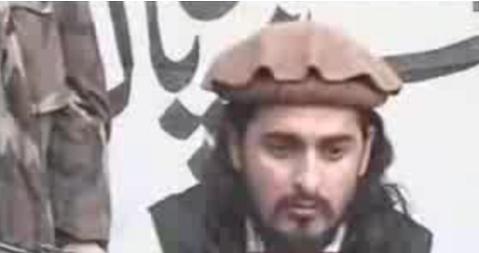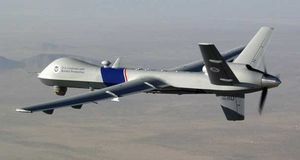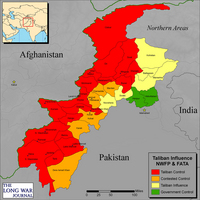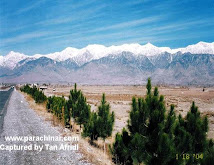The US targeted a Taliban compound in a cross-border strike into Pakistan's tribal areas today. The strike took place in the Kurram tribal agency and was the second attack there since December 2008.
The Predator airstrike hit a Taliban compound and training camp in the Barjo region in Kurram. "The training camp was completely destroyed," a villager told Reuters. At least four Hellfire missiles were reported to have been fired at the camp.
Unconfirmed reports indicate up to 14 people, including "foreigners," were reported killed in the attack. The term "foreigners" is often used to describe al Qaeda operatives sheltering in Pakistan's tribal areas. No senior al Qaeda or Taliban leaders have been reported at this time.
Today's attack is the first since March 1, when Predators targeted a Taliban compound in a region of South Waziristan controlled by Pakistani Taliban leader Baitullah Mehsud.
The first US attack in Kurram took place on Feb. 16 of this year. More than 30 people, including Arab al Qaeda fighters, were reported killed in the attack.
Previous airstrikes have focused on Taliban and al Qaeda training camps and safe houses in the tribal agencies of Bajaur and North and South Waziristan. One other strike hit a Taliban camp in the settled district of Bannu in the Northwest Frontier Province.
The Taliban have expanded their control into Kurram by backing the wave of sectarian fighting between Sunni and Shia in the region. The Shia have been forced into small enclaves in Parachinar and other areas as the Pakistani military has refused to come to their aid.
The Taliban have used Kurram as a training ground for their forces and have established several bases in the agency, an intelligence official familiar with the situation in Pakistan's tribal areas told The Long War Journal on the condition of anonymity.
| 
Taliban commander Hakeemullah Mehsud is behind the attacks on NATO convoys in Khyber and Peshawar. Photo provided to The Long War Journal by Bill Longley.. |
| |
The Taliban in Kurram are led by Hakeemullah Mehsud, a rising star in the Pakistani Taliban. Hakeemullah is a senior lieutenant and cousin of Pakistani Taliban leader Baitullah Mehsud; he is also a cousin of Qari Hussain Mehsud, the notorious Taliban commander who trains child suicide bombers in South Waziristan.
Hakeemullah has been leading operations against NATO's supply lines in Khyber and Peshawar. He also commands the Taliban in the Arakzai and Khyber tribal agencies.
Background on US strikes against al Qaeda and Taliban networks in northwestern Pakistan
Click map for full view.
Taliban presence, by district and tribal agency, the Northwest Frontier Province and the Federally Administered Tribal Agencies. Information on Taliban presence obtained from open source and derived by The Long War Journal based on the presence of Taliban shadow governments, levels of fighting, and reports from the region. Map created by Bill Raymond for The Long War Journal.
US intelligence believes al Qaeda has reconstituted its external operations network in Pakistan's lawless, Taliban-controlled tribal areas. This network is tasked with hitting targets in the West, India, and elsewhere. The US has struck at these external cells using unmanned Predator aircraft and other means in an effort to disrupt al Qaeda's external network and decapitate the leadership. The US has also targeted al Qaeda-linked Taliban fighters operating in Afghanistan, particularly the notorious Haqqani Network.
As of last summer, al Qaeda and the Taliban operated 157 known training camps. Al Qaeda has been training terrorists holding Western passports to conduct attacks, US intelligence officials have told The Long War Journal. Some of the camps are devoted to training the Taliban's military arm, some train suicide bombers for attacks in Pakistan and Afghanistan, some focus on training the various Kashmiri terror groups, some train al Qaeda operatives for attacks in the West, some train the Lashkar al Zil, al Qaeda's Shadow Army, and one serves as a training ground for the Black Guard, the elite bodyguard for Osama bin Laden, Ayman al Zawahiri, and other senior al Qaeda leaders.
There were 36 recorded cross-border attacks and attempts in Pakistan during 2008, according to numbers compiled by The Long War Journal. Twenty-nine of these attacks took place after Aug. 31. There were only 10 recorded strikes in 2006 and 2007 combined.
During 2008, the US strikes inside Pakistan's tribal areas killed five senior al Qaeda leaders. All of the leaders were involved in supporting al Qaeda's external operations directed at the West.
Abu Laith al Libi, a senior military commander in Afghanistan, was killed in a strike in North Waziristan in January 2008.
Abu Sulayman Jazairi, al Qaeda's external operations chief, was killed in a strike in Bajaur in March 2008.
Abu Khabab al Masri, al Qaeda's weapons of mass destruction chief, and several senior members of his staff were killed in a strike in South Waziristan in July 2008.
Khalid Habib, the leader of al Qaeda's paramilitary Shadow Army, was killed in a region controlled by Baitullah Mehsud in South Waziristan in October 2008.
Abu Jihad al Masri, the leader of the Egyptian Islamic Group and member of al Qaeda's top council, was also killed in North Waziristan in October 2008.
In 2009, US strikes have killed two senior, long-time al Qaeda leaders. Osama al Kini and his senior aide, Sheikh Ahmed Salim Swedan, were killed in a New Years Day strike in South Waziristan. Kini was al Qaeda operations chief in Pakistan. Both men were behind the 1998 bombings of the US embassies in Dar es Salaam, Tanzania; and Nairobi, Kenya; which killed 224 civilians and wounded more than 5,000 others.
US attacks inside Pakistan during 2009:
• US missile strike in Kurram agency kills 14
March 12, 2009
• US airstrike kills eight in South Waziristan
March 1, 2009
• US airstrike in Pakistan's Kurram tribal agency kills 30
Feb. 16, 2009
• US Predator strike in South Waziristan kills 25
Feb. 14, 2009
• US strikes al Qaeda in North and South Waziristan
Jan. 23, 2009
• US hits South Waziristan in second strike
Jan. 2, 2009
• US kills four al Qaeda operatives in South Waziristan strike
Jan. 1, 2009
SOURCE: http://www.longwarjournal.org/archives/2009/03/us_missile_strike_in.php

 www.parachinar616.blogspot.com
www.parachinar616.blogspot.com












 KURRAM AGENCY: At least 14 people were killed Thursday in suspected US missile strikes in Kurram Agency.
KURRAM AGENCY: At least 14 people were killed Thursday in suspected US missile strikes in Kurram Agency.









